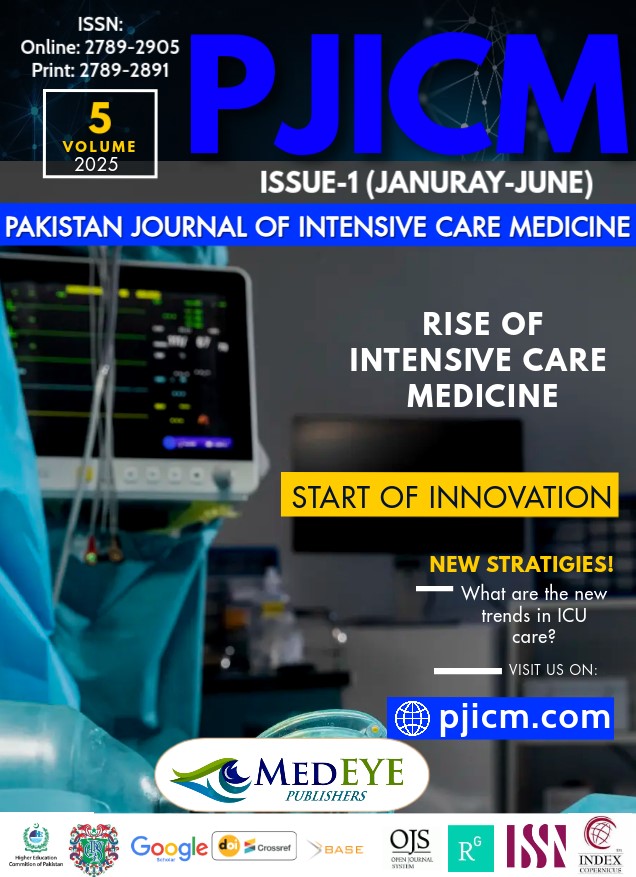USE OF G10 SCORING SYSTEM TO PREDICT DIFFICULT LAPAROSCOPIC CHOLECYSTECTOMY AND CONVERSION TO OPEN CHOLECYSTECTOMY
DOI:
https://doi.org/10.54112/pjicm.v5i01.53Keywords:
Laparoscopic Cholecystectomy, Conversion to Open Surgery, G10 Scoring System, Risk Factors, Difficult CholecystectomyAbstract
Background: Laparoscopic cholecystectomy (LC) is the gold standard for treating gallbladder disease; however, some cases present technical challenges that necessitate conversion to open cholecystectomy (OC). Identifying factors associated with difficult LC and conversion to OC can help optimize surgical planning and patient counseling. Objective: To evaluate the frequency of difficult laparoscopic cholecystectomies and the rate of conversion to open cholecystectomies in patients undergoing laparoscopic cholecystectomy (LC). Study Design: Observational cross-sectional study. Setting: The study was conducted at Saidu Teaching Hospital in Swat. Duration of Study: The study was conducted over six months, from August 16, 2024, to February 16, 2025. Methods: A total of 126 patients undergoing laparoscopic cholecystectomy (gallbladder surgery) were included. Surgical difficulty was assessed using the G10 scoring system, which evaluates factors such as inflammation, adhesions, and anatomical variations. Conversion rates from LC to OC were recorded. Demographic characteristics, surgical difficulty, and outcome variables were analyzed using SPSS version 20. The statistical significance of the predictive factors was assessed, with p-values of less than 0.05 considered significant. Results: Difficult labor was observed in 14 patients (11.1%), while conversion to cesarean section was required in 8 cases (6.3%). Age and gender were significant predictors of difficult LC and conversion to OC. Patients with a higher BMI (>24.9 kg/m²) had an increased likelihood of complex surgery and conversion; however, the association was not statistically significant. Conclusion: The frequency of difficult laparoscopic cholecystectomy was 11.1%, and the conversion rate to open surgery was 6.3%. Age and gender were notable predictive factors for surgical difficulty and conversion. Preoperative risk assessment using scoring systems, such as G10, can aid in surgical decision-making and improve patient outcomes.
References
Friedman GD. Natural history of asymptomatic and symptomatic gallstones. Am J Surg. 1993;165(4):399-404..
Gallaher JR, Charles A. Acute cholecystitis: a review. JAMA. 2022;327(10):965-75.
Huang SS, Lin KW, Liu KL, Wu YM, Lien WC, Wang HP. Diagnostic performance of ultrasound in acute cholecystitis: a systematic review and meta-analysis. World J Emerg Surg. 2023;18(1):54.
de Oliveira GS, Torri GB, Gandolfi FE, Dias AB, Tse JR, Francisco MZ, et al. Computed tomography versus ultrasound for the diagnosis of acute cholecystitis: a systematic review and meta-analysis. Eur Radiol. 2024;34: 6967–79
Spira RM, Nissan A, Zamir O, Cohen T, Fields SI, Freund HR. Percutaneous transhepatic cholecystostomy and delayed laparoscopic cholecystectomy in critically ill patients with acute calculus cholecystitis. Am J Surg. 2002;183(1):62-6.
Eldar S, Sabo E, Nash E, Abrahamson J, Matter I. Laparoscopic cholecystectomy for acute cholecystitis: prospective trial. World J Surg. 1997;21:540-5.
Lo CM, Liu CL, Fan ST, Lai EC, Wong J. Prospective randomized study of early versus delayed laparoscopic cholecystectomy for acute cholecystitis. Ann Surg. 1998;227(4):461-7.
Rosen M, Brody F, Ponsky J. Predictive factors for conversion of laparoscopic cholecystectomy. Am J Surg. 2002;184(3):254–8
A nationwide study of conversion from laparoscopic to open cholecystectomy Am J Surg, 2004;188(3) 205-11.
Hernandez M, Murphy B, Aho JM, Haddad NN, Saleem H, Zeb M, et al. Validation of the AAST EGS acute cholecystitis grade and comparison with the Tokyo guidelines. Surgery. 2018;163(4):739-46.
Madni TD, Leshikar DE, Minshall CT, Nakonezny PA, Cornelius CC, Imran JB, et al. The Parkland grading scale for cholecystitis. Am J Surg. 2018;215(4):625-30.
Sugrue M, Sahebally SM, Ansaloni L, Zielinski MD. Grading operative findings at laparoscopic cholecystectomy-a new scoring system. World J Emerg Surg. 2015;10(1):1-8.
Sakpal SV, Bindra SS, Chamberlain RS. Laparoscopic Cholecystectomy Conversion Rates Two Decades Later. JSLS. 2010;14(4):476-483.
Ali G, Zeb M, Khattak A, Khan R, Dawar MK, Zaman K, et al. Frequency and predictors of conversion from laparoscopic to open cholecystectomy: a single-center observational study. Cureus. 2024;16(12):e76327.
Abdulhussein BJ, Hussein YF, Nawar AH, et al. Conversion rate of laparoscopic cholecystectomy to open surgery at Al Karamah Teaching Hospital, Iraq. Surg Sci. 2015;6:221-226.
Warchałowski Ł, Łuszczki E, Bartosiewicz A, et al.: The analysis of risk factors in the conversion from laparoscopic to open cholecystectomy. Int J Environ Res Public Health. 2020, 17:7571.
Hu AS, Menon R, Gunnarsson R, de Costa A: Risk factors for conversion of laparoscopic cholecystectomy to open surgery - a systematic literature review of 30 studies. Am J Surg. 2017, 214:920-30.
Downloads
Published
How to Cite
Issue
Section
License
Copyright (c) 2025 SF SUBHAN , F AKBAR

This work is licensed under a Creative Commons Attribution-NonCommercial 4.0 International License.












